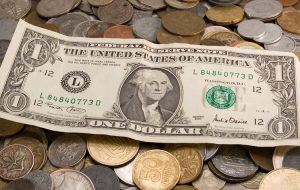US Dollar prints eleventh straight weekly gain ahead of US government shutdown on Sunday
[ad_1] Share: Markets are digesting the recent PCE numbers. Chicago PMI number deteriorates further. The US Dollar Index clings on to an 11th weekly positive close. The US Dollar (USD) is trying to hold on to another weekly gain, though it looks like either a make-or-break deal. If the US Dollar holds onto gains,

[ad_1]
- Markets are digesting the recent PCE numbers.
- Chicago PMI number deteriorates further.
- The US Dollar Index clings on to an 11th weekly positive close.
The US Dollar (USD) is trying to hold on to another weekly gain, though it looks like either a make-or-break deal. If the US Dollar holds onto gains, this would be the 11th consecutive weekly gain for the US Dollar Index (DXY).
While the US Dollar Index closed each week near the high of that same week, that does not look to be the case for this week. With the United Auto Workers (UAW) union strikes continuing, more independent workers joining the picket lines and a US federal government shutdown expected to start this weekend, things are starting to look grim for the Greenback.
No the expect oil-on-the-fire from the Federal Reserve (Fed) preferred inflation gauge: the Procuder Price Index. Nearly every number fell in line of expectations, making it a snooze fest in the markets. The Chicago Purchase Manager’s Index (PMI) deteriorated further and could mean issues ahead of future PMI numbers.
Daily digest: US Dollar lacks fuel
- The Personal Consumption Expenditures (PCE) Index came in, in line of expectations: Overall yearly component whent from 3.4% to 3.5%. The monthly measure from 0.2%to 0.4%. The Core PCE yearly component from 4.3% to 3.9%. The monthly core PCE from 0.2% to 0.1%. Again energy was the main driver for a higher overall component against a lower core.
- Additionally, traders saw Personal Income ticking up from 0.2% to 0.4%, in lin eof expectations. Personal Spending went from 0.9% to 0.4%, as well in line.
- Tthe Chicago Purchasing Managers Index (PMI) for September dropped below estimates to 44.1 from 48.7.
- University of Michigan final readings saw Sentiment tick up from 67.7 to 68.1. The inflation expectation fell in line from 2.7 to 2.8%.
- Equities are mixed with Hong Kong’s Hang Seng Index roaring over 3%, while in Japan the Nikkei and the Topix are down for this Friday at their closing bell. The Nikkei is even trading near a one-month low. In Europe equities are set to close in the green with US equity futures seeing Nasdaq leading the charge.
- The CME Group FedWatch Tool shows that markets are pricing in an 82.7 % chance that the Federal Reserve will keep interest rates unchanged at its meeting in November.
- The benchmark 10-year US Treasury yield trades are lower at 4.52%, which is quite a step away from 4.68% earlier this week. Investors are starting to buy bonds in order to safely park funds over the weekend with the government shutdown at hand.
US Dollar Index technical analysis: locked and loaded
The US Dollar tries to cling on to gains as this week might be proven pivotal for its winning streak since the summer. The US Dollar Index is set to print its 11th straight weekly gain, though headwinds are building up. With the UAW strike, the US Government shutdown and GDP miss are signs not to be ignored with possibly a firm unwind of the current Dollar bull positions that have been built up.
The US Dollar Index opened around 106.15, though the overheated Relative Strength Index (RSI) starts to ease and is out of the overbought area. Traders that want to hit a new 52-week high need to be aware that a lot of road needs to be covered toward 114.78. Rather look for 107.19, the high of November 30, 2022, as the next profit target on the upside.
On the downside, the recent resistance at 105.88 should be seen as first support. Still, that barrier has just been broken to the upside, so it isn’t likely to be strong. Instead, look for 105.12 to do the trick and keep the DXY above 105.00.
Central banks FAQs
Central Banks have a key mandate which is making sure that there is price stability in a country or region. Economies are constantly facing inflation or deflation when prices for certain goods and services are fluctuating. Constant rising prices for the same goods means inflation, constant lowered prices for the same goods means deflation. It is the task of the central bank to keep the demand in line by tweaking its policy rate. For the biggest central banks like the US Federal Reserve (Fed), the European Central Bank (ECB) or the Bank of England (BoE), the mandate is to keep inflation close to 2%.
A central bank has one important tool at its disposal to get inflation higher or lower, and that is by tweaking its benchmark policy rate, commonly known as interest rate. On pre-communicated moments, the central bank will issue a statement with its policy rate and provide additional reasoning on why it is either remaining or changing (cutting or hiking) it. Local banks will adjust their savings and lending rates accordingly, which in turn will make it either harder or easier for people to earn on their savings or for companies to take out loans and make investments in their businesses. When the central bank hikes interest rates substantially, this is called monetary tightening. When it is cutting its benchmark rate, it is called monetary easing.
A central bank is often politically independent. Members of the central bank policy board are passing through a series of panels and hearings before being appointed to a policy board seat. Each member in that board often has a certain conviction on how the central bank should control inflation and the subsequent monetary policy. Members that want a very loose monetary policy, with low rates and cheap lending, to boost the economy substantially while being content to see inflation slightly above 2%, are called ‘doves’. Members that rather want to see higher rates to reward savings and want to keep a lit on inflation at all time are called ‘hawks’ and will not rest until inflation is at or just below 2%.
Normally, there is a chairman or president who leads each meeting, needs to create a consensus between the hawks or doves and has his or her final say when it would come down to a vote split to avoid a 50-50 tie on whether the current policy should be adjusted. The chairman will deliver speeches which often can be followed live, where the current monetary stance and outlook is being communicated. A central bank will try to push forward its monetary policy without triggering violent swings in rates, equities, or its currency. All members of the central bank will channel their stance toward the markets in advance of a policy meeting event. A few days before a policy meeting takes place until the new policy has been communicated, members are forbidden to talk publicly. This is called the blackout period.
[ad_2]
لینک منبع : هوشمند نیوز
 آموزش مجازی مدیریت عالی حرفه ای کسب و کار Post DBA آموزش مجازی مدیریت عالی حرفه ای کسب و کار Post DBA+ مدرک معتبر قابل ترجمه رسمی با مهر دادگستری و وزارت امور خارجه |  آموزش مجازی مدیریت عالی و حرفه ای کسب و کار DBA آموزش مجازی مدیریت عالی و حرفه ای کسب و کار DBA+ مدرک معتبر قابل ترجمه رسمی با مهر دادگستری و وزارت امور خارجه |  آموزش مجازی مدیریت کسب و کار MBA آموزش مجازی مدیریت کسب و کار MBA+ مدرک معتبر قابل ترجمه رسمی با مهر دادگستری و وزارت امور خارجه |
 مدیریت حرفه ای کافی شاپ |  حقوقدان خبره |  سرآشپز حرفه ای |
 آموزش مجازی تعمیرات موبایل آموزش مجازی تعمیرات موبایل |  آموزش مجازی ICDL مهارت های رایانه کار درجه یک و دو |  آموزش مجازی کارشناس معاملات املاک_ مشاور املاک آموزش مجازی کارشناس معاملات املاک_ مشاور املاک |
برچسب ها :ahead ، Dollar ، DollarIndex ، Eleventh ، Gain ، government ، macroeconomics ، Prints ، seo ، shutdown ، straight ، Sunday ، UnitedStates ، Weekly
- نظرات ارسال شده توسط شما، پس از تایید توسط مدیران سایت منتشر خواهد شد.
- نظراتی که حاوی تهمت یا افترا باشد منتشر نخواهد شد.
- نظراتی که به غیر از زبان فارسی یا غیر مرتبط با خبر باشد منتشر نخواهد شد.





ارسال نظر شما
مجموع نظرات : 0 در انتظار بررسی : 0 انتشار یافته : ۰